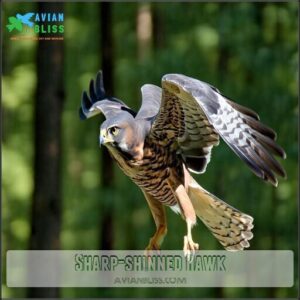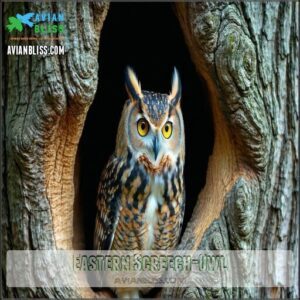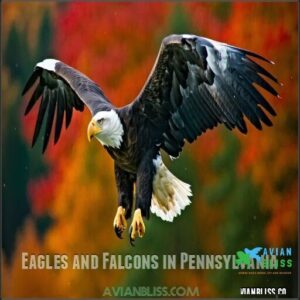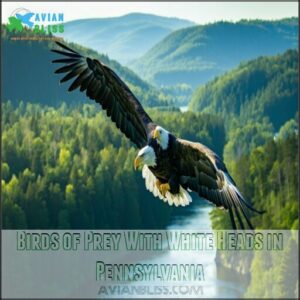This site is supported by our readers. We may earn a commission, at no cost to you, if you purchase through links.

You’ll find red-tailed hawks circling fields, Cooper’s hawks darting through woodlands, and bald eagles patrolling rivers.
Owls, like the great horned and barred, dominate the night with their silent flight. Even vultures play cleanup crews, scanning for carrion with unmatched efficiency.
These raptors help keep ecosystems balanced by controlling pests and scavenging. Want to spot one? Look up in the open sky or scan treetops near water.
Each species has its quirks—stick around to learn some surprising details about Pennsylvania’s winged predators.
Table Of Contents
- Key Takeaways
- Birds of Prey in Pennsylvania
- Types of Hawks in Pennsylvania
- Owl Species in Pennsylvania
- Eagles and Falcons in Pennsylvania
- Vultures in Pennsylvania
- Other Birds of Prey in Pennsylvania
- Raptor Conservation in Pennsylvania
- Birds of Prey in Northern Pennsylvania
- Birds of Prey With White Heads in Pennsylvania
- Smallest Bird of Prey in Pennsylvania
- Frequently Asked Questions (FAQs)
- Are there birds of prey in Pennsylvania?
- What are the smallest birds of prey in Pennsylvania?
- What is the tiniest Raptor in Pennsylvania?
- When do Ospreys come to Pennsylvania?
- Is Pennsylvania a good state for birdwatching & conservation?
- Are Merlin Raptors common in Pennsylvania?
- Can you name the biggest bird found in the Keystone State?
- Which bird has the quickest top speed?
- What are the big birds of prey in PA?
- Did I see a hawk or a falcon?
- Conclusion
Key Takeaways
- You’ll spot incredible hunters like Red-tailed Hawks, Great Horned Owls, and Bald Eagles in Pennsylvania, each dominating different habitats.
- These raptors are vital to ecosystems, keeping prey populations in check and scavenging to prevent disease.
- Birdwatching hotspots like Hawk Mountain or rivershores are perfect for catching these predators in action.
- Conservation efforts, from habitat protection to reducing pesticide use, are crucial for the survival of these majestic birds.
Birds of Prey in Pennsylvania
You’ll find an incredible variety of birds of prey soaring through Pennsylvania’s skies, from hawks and owls to eagles and falcons.
These skilled hunters play a pivotal role in keeping ecosystems balanced, making them as fascinating as they’re important, and are a crucial part of the ecosystem with their ability to keep it balanced.
Definition of Birds of Prey
Watching a raptor in action feels like witnessing nature’s precision-engineered hunters at work.
Pennsylvania birds of prey, or raptors, stand out for their extraordinary hunting adaptations that have been perfected over millions of years.
Here are the three signature traits that make these predators so fascinating:
- Raptor Traits: Curved talons and hooked beaks give them the ultimate tools for catching, gripping, and tearing prey.
- Enhanced Vision: Their eyesight is a marvel, up to eight times sharper than human vision.
- Hunting Styles: Whether it’s the silent flight of an owl or the Peregrine Falcon’s record-breaking dive over 240 mph, their aerial mastery is unmatched.
These keystone species keep ecosystems balanced, controlling rodent and pest populations efficiently.
Nature’s pest control at its finest!
Characteristics of Birds of Prey
When you see Pennsylvania birds of prey soaring above, you’re watching masters of the sky. Their distinct bird of prey characteristics, like sharp, hooked beaks, razor-like talons, and extraordinary vision, make them expert avian predators.
These features aren’t just for show—they’re fine-tuned for survival. Raptor morphology is fascinating, with wings designed for soaring silently or diving at breakneck speeds.
Take the Peregrine Falcon—it hits speeds over 200 mph to snag prey midair, a true marvel of flight patterns and hunting techniques.
Meanwhile, hawks, like the Red-tailed Hawk, rely on patience, perching high to spot unsuspecting prey below. Sensory adaptations help them detect movement even from hundreds of feet away.
Every bird adaptation tells a story of evolution, making these incredible hunters essential to managing ecosystems. Look up—you might spot one hunting!
Importance of Birds of Prey in Ecosystems
Birds of prey in Pennsylvania play a pivotal role in keeping ecosystems running smoothly, like nature’s own quality control team.
These skilled hunters don’t just look impressive—they’re a big deal for the environment.
Pennsylvania raptors help in powerful ways:
- Ecosystem Balance: By hunting, they prevent prey species from overrunning their habitats.
- Rodent Control: Hawks and owls are your best allies against destructive rodent populations.
- Indicator Species: Their presence signals a healthy, thriving environment.
- Scavenging Benefits: Some clean up dead animals, stopping diseases from spreading.
- Food Web Stability: Raptors maintain balance by controlling prey populations.
So, when a hawk’s shadow sweeps across the ground or an owl silently watches from a branch, it’s more than a bird—it’s a sign of healthy ecological relationships at work.
Raptor conservation isn’t just about birds; it’s about preserving Pennsylvania’s rich avian diversity and nature’s harmony!
Types of Hawks in Pennsylvania
If you’ve ever seen a hawk soaring overhead in Pennsylvania, you’re witnessing one of nature’s most skilled predators.
From the Red-tailed Hawk’s fiery tail to the Sharp-shinned Hawk’s lightning-fast maneuvers, these raptors are as diverse as they’re fascinating.
Red-tailed Hawk
The Red-tailed Hawk is one of the most common PA hawks, easily recognized by its rusty-red tail and varied pale-to-dark plumage.
Whether perched on roadside poles or soaring in elegant circles, this magnificent raptor thrives in diverse Red-tailed habitats like forests, mountains, and suburban parks.
With a wingspan of 45-52 inches, it’s a commanding sight among PA birds of prey.
Known for their adaptable hunting behavior, these hawks rely on strength, not speed, diving at 120 mph to capture prey like rodents, rabbits, and snakes.
Their Red-tailed diet is all about controlling pests, so they’re essential to ecosystems.
For assistance with accurate hawk identification, resources are available.
Thanks to effective conservation, the Redtailed Hawk enjoys a stable conservation status, making it a must-see star among Pennsylvania raptors.
Sharp-shinned Hawk
The Sharp-shinned Hawk, one of the most agile forest hunters among common PA hawks, is a raptor you can’t ignore.
Just 9-13 inches long, this compact predator masters dense forest habitats with acrobatic flight and incredible hunting behavior.
You’ll find them snatching small birds mid-air, showcasing speed and precision that’s nothing short of mesmerizing.
Their plumage variations stand out—a sleek slate-blue back paired with rusty-barred undersides.
Females are nearly double the size of males, making Sharp-shinned Hawks one of nature’s best examples of a role reversal.
You can even find identification-related merchandise for these birds.
- Look for square-tipped tails and rounded wings, built for sharp turns in tight spaces.
- Listen for their high-pitched “kik-kik-kik” calls echoing through the woods.
- Spot stick nests hidden in coniferous trees during breeding season.
- Catch them during migration as they soar over Pennsylvania ridgetops.
- Note their steady population trends—a hopeful sign for PA birds of prey.
Cooper’s Hawk
Cooper’s Hawks are the stealthy ninjas of Pennsylvania’s forests, often spotted gliding gracefully through the trees or lurking near suburban bird feeders.
With slate-gray backs, bold rusty streaks on their underparts, and fiery red eyes, they’re hard to mistake.
These raptors are masters of hawk identification PA, using their calculated hunting behavior to ambush songbirds mid-flight.
Their habitat preference includes mixed forests and tall suburban trees, where they build nests up to 50 feet high.
Though similar to the Sharp-shinned Hawk, they’re bulkier with broader shoulders.
Explore options for Cooper’s Hawk identification for related merchandise.
For birdwatchers, spotting one feels like uncovering a secret agent in action.
Northern Harrier
Northern Harriers are expert hunters, gliding low over fields and marshes in Pennsylvania.
These raptors have some fascinating physical adaptations, making them unique among hawks:
- V-shaped wings allow graceful hovering.
- Owl-like facial disks amplify hearing to locate hidden prey.
- A white rump patch acts as their signature feature.
- Low-altitude hunting techniques help find small mammals.
You’ll often spot this hawk at sunrise, tilting across open landscapes.
Unfortunately, habitat loss threatens them, so protecting wetlands boosts their conservation status in Pennsylvania’s wildlife scene.
Red-shouldered Hawk
You’ve probably spotted the Red-shouldered Hawk if you’ve wandered near forests with water. Known for their rust-colored shoulders and striking black-and-white wings, these raptors are showstoppers.
- Found in forest habitats near ponds or streams.
- Their hunting behavior covers small mammals, frogs, and more.
- Look up for their translucent wingtips in flight.
- Nesting habits involve tall, mature trees.
- Loud "kee-aah" vocalizations echo like nature’s car alarm.
A keener eye reveals nature’s charm!
Owl Species in Pennsylvania
Pennsylvania is home to an impressive variety of owls, from the tiny Eastern Screech-Owl to the majestic Great Horned Owl.
You’ll find them in forests, fields, and even urban areas, each with unique calls and fascinating adaptations.
Great Horned Owl
In the domain of ruling the night skies, the Great Horned Owl reigns supreme.
With its piercing yellow eyes and striking ear tufts, this owl species in Pennsylvania is built for stealth and power. Blending seamlessly into forests or suburban backyards, their feather camouflage mimics tree bark perfectly.
Known for silent flight and crushing talons, their hunting techniques are a masterpiece of nature. The Great Horned Diet includes rabbits, skunks, and even birds, showcasing their adaptability.
Their nesting habits vary regionally, but they often reuse old hawk or squirrel nests. Among owl calls in Pennsylvania, their deep “hoo-hoo-hoo” claim the night with authority.
Barred Owl
The Barred Owl is one of the most charming owl species in Pennsylvania, especially when its signature "who-cooks-for-you" call rings through the woods. With soulful dark eyes and chocolate-brown barring, this owl is equal parts mysterious and enchanting.
You’ll most likely spot Barred Owls in dense, mature forests near water, their favorite habitat. They nest in tree cavities or take over abandoned hawk nests.
Strictly nocturnal, these raptors silently swoop down on prey such as small mammals and amphibians, relying on their sharp hunting skills. Their calls, which serve territorial marking purposes, can travel long distances.
Here’s what makes the Barred Owl stand out:
- Chocolate-brown stripes and dark eyes
- Prefers wooded areas near water
- Eats mostly mammals and amphibians
- Famous territorial calls resembling human laughter
- Beneficial as a predator in forest ecosystems
Long-eared Owl
Though smaller than some owl species in Pennsylvania, the Long-eared Owl is a master of stealth.
Its prominent ear tufts and yellow eyes make it unmistakable. These owls blend seamlessly into forests, using their incredible camouflage techniques to stay hidden.
They’re nocturnal, feasting on voles during their hunts.
Their nests, often abandoned crow or hawk homes, shelter 3-8 owlets each season.
Long-eared Owls, known for their social habits, roost together in winter. But watch out—they’re listed as vulnerable in Pennsylvania.
| Trait | Details | Fun Fact |
|---|---|---|
| Size | 13-16 inches long | Fits right into dense foliage |
| Diet | Small mammals, voles | Masters of vole predation |
| Conservation Status | Vulnerable in PA | Protected due to habitat loss |
Eastern Screech-Owl
The Eastern Screech-Owl is a pint-sized predator with two distinct plumage variations: rusty-red and gray, blending seamlessly into tree bark.
These owls thrive in Pennsylvania’s forests, parks, and suburbs, showing impressive urban adaptation. You’ll hear their haunting trill calls after sunset, a signature of their lively presence.
- Screech-Owl Diet: Small mammals, insects, and birds.
- Nesting Habits: Tree cavities.
- Call Significance: Communication and territory defense.
Snowy Owl
The Snowy Owl, one of the stunning owl species in Pennsylvania, graces the state during its Arctic migration in winter.
Known for its plumage variation, males are nearly pure white, while females and juveniles flaunt bold dark barring.
Their prey specialization includes rodents and birds, hunted in open fields mimicking Arctic tundra.
- Rotates its head up to 270 degrees for a better view.
- Hunts during daylight, unlike most owls.
- Flies silently, startling prey with its sharp talons.
- Faces challenges from habitat loss, affecting its conservation status.
Eagles and Falcons in Pennsylvania
You’ll find some of Pennsylvania’s most impressive hunters among its eagles and falcons, like the mighty Bald Eagle and the lightning-fast Peregrine Falcon.
These birds are masters of the sky, blending speed, power, and sharp vision to spot prey from incredible distances, showcasing their sharp vision.
Bald Eagle
The Bald Eagle is America’s powerhouse in the skies and Pennsylvania’s pride.
With its unmistakable white head and tail, paired with a chocolate-brown body, it’s a sight that stops you in your tracks.
These raptors are built for dominance, boasting a wingspan of up to 7.5 feet—practically the size of your sofa.
You’ll often catch them near rivers, lakes, and reservoirs, eyeing fish—about 70-90% of their diet.
They’re not picky eaters, though; small mammals and waterfowl occasionally make the menu.
Their nests? Gigantic showpieces!
Nesting high in trees, Pennsylvania eagle nests can weigh over a ton and measure 8 feet wide, almost like a second bedroom.
Thanks to conservation work, the eagle population has soared back from near extinction.
For a close-up, check out eagle watching in PA hotspots like Pymatuning Reservoir, perfect for admiring this ultimate symbol of freedom and power.
Peregrine Falcon
Peregrine Falcons are Pennsylvania’s aerial acrobats, famed for their record-breaking speed.
While Bald Eagles dominate waterways, these Urban Falcons reach jaw-dropping speeds of 240 mph during hunting dives! It’s like watching a feathered race car.
Here are five incredible facts about Peregrine Falcons:
- They’re Earth’s fastest animals, clocking over 240 mph.
- Adapted from cliff faces to cities, nesting on skyscrapers and bridges.
- Razor-sharp vision lets them spot prey nearly a mile away.
- Their global migrations can span 15,500 miles annually.
- Conservation efforts saved them post-DDT bans—talk about a comeback!
Look for this Pennsylvania falcon species near cities, cliffs, or while birdwatching Pennsylvania landmarks, and witness their record-breaking speed in action, with their aerial acrobats skills.
American Kestrel
The American Kestrel, the tiniest of Pennsylvania falcon species, is nature’s pocket-sized predator. You’ll spot these vibrant birds—rusty-red backs, slate-blue wings, and striking facial markings—hovering over fields before striking prey.
Their kestrel diet includes insects, mice, and even small birds, showcasing sharp precision and speed. Kestrel habitat spans farmlands, meadows, and forest edges statewide.
- Watch them hover perfectly still, like they’re defying gravity.
- Hear their unique “killi-killi-killi” calls echoing nearby.
- Admire their versatility in diverse landscapes.
- Support kestrel conservation to protect these agile beauties!
Merlin
The Merlin is a small but mighty falcon that thrives in Pennsylvania’s open woodlands and grasslands.
Known for its breathtaking speed and precision, this raptor is a skilled hunter, often chasing down small birds mid-flight.
Unlike larger falcons, Merlins rely on agility and quick maneuvers, especially during migration.
Spotting one is a thrill for birding enthusiasts, and protecting their habitats guarantees these pint-sized predators continue to dominate Pennsylvania’s skies with unmatched flair.
Vultures in Pennsylvania
You’ve probably spotted vultures circling in the sky, gliding effortlessly as they search for food.
In Pennsylvania, these scavengers play a key role in the ecosystem by cleaning up carcasses, with Turkey Vultures and Black Vultures leading the way.
Turkey Vulture
Turkey Vultures are your go-to cleanup crew in Pennsylvania’s skies.
With their bald red heads (nature’s cleanup tool) and a sharp sense of smell, they spot carrion from miles away.
You may catch these scavenging raptors gliding gracefully in a V-shape while silently patrolling forests, farms, or highways.
Here’s how these birds contribute to the ecosystem:
- Boost public health by eating decaying animals, reducing disease spread.
- Recycle nutrients back into the earth, enriching soil life.
- Keep nature tidy by removing what others leave behind.
Their humble Turkey Vulture diet is key to birdwatching marvels and understanding vulture ecological roles.
They’re proof nature thrives on balance!
Black Vulture
Black Vultures are striking raptors in Pennsylvania wildlife, easy to spot with their glossy black feathers and bold presence. Compared to their Turkey Vulture relatives, they’re more than just carrion eaters—they’ll hunt small prey if food’s scarce, showing their sharp instincts.
Their quick, choppy flight adds a dramatic touch to the skies, while their black heads and broad wings provide an unmistakable ID.
These social vultures thrive in open areas, often roosting in groups in trees or dense thickets, showcasing strong bonds. Their range expansion in Pennsylvania highlights their adaptability.
Despite their scavenger reputation, Black Vultures play a pivotal ecological role by cleaning up carcasses, helping maintain a healthy ecosystem. They remind us that nature’s janitors can soar just as magnificently as any bird of prey, with a magnificent ability to thrive.
Differences Between Vultures and Hawks
A hawk’s world is about precision. These sharp-eyed hunters, like the Red-tailed Hawk, rely on speed, talons, and zigzagging flight patterns to track live prey.
On the flip side, vultures, such as the Turkey Vulture, play cleanup crew, sniffing out carcasses to recycle into the ecosystem. It’s like hawks are the gymnasts, while vultures are nature’s janitors.
- Hunting Styles: Hawks hunt live prey; vultures scavenge.
- Physical Traits: Hawks have sleek feathers for agility; vultures have broader wings for gliding.
- Diet Differences: Hawks focus on fresh kills, while vultures specialize in carrion.
Hawks and vultures both fill unique roles in Pennsylvania’s ecosystems, each ensuring nature stays in balance. To attract more birds, consider planting native trees.
Other Birds of Prey in Pennsylvania
You’ll find some incredible birds of prey in Pennsylvania that don’t fit neatly into other categories, like the osprey or short-eared owl.
These fascinating raptors each bring their own unique traits, whether it’s hovering near water or silently gliding over open fields.
Rough-legged Hawk
Rough-legged Hawks bring a touch of the Arctic to Pennsylvania during winter.
Their feathered legs, built for tundra habitat, set them apart.
These raptors often hover mid-air, scanning farmland or open fields for their favorite meal—voles.
Known for Arctic migration patterns and lemming dependence, they appear in striking color morphs, from light to dark.
Keep an eye out during Pennsylvania sightings; any leg bands could mean you’re observing a significant part of conservation efforts tracking these skilled hunters.
Osprey
Spotting an osprey in Pennsylvania is a real treat for birding enthusiasts.
These raptors thrive near rivers, lakes, and reservoirs, where their remarkable hunting skills shine.
With their white bellies and bold dark eyestripes, they’re easy to spot once you know what to look for.
Ospreys have fascinating adaptations that make them fishing experts:
- Their reversible outer toes grasp slippery fish securely.
- Barbed footpads give them extra grip.
- They can dive up to three feet underwater, sealing their nostrils while hunting.
- Fish are carried headfirst for speed and control.
- Boasting a 70% hunting success rate, their diet is almost exclusively fish!
Add an osprey sighting to your Pennsylvania bird-watching checklist.
American Barn Owl
The American Barn Owl stands out with its ghostly flight and heart-shaped face, often thrilling birding enthusiasts in Pennsylvania.
These owls prefer barns, hollow trees, and fields, where they expertly control rodents. Their screeches, unlike the hoots of other owl species, can sound a bit spooky—but they’re nature’s pest managers!
Here’s a quick table of owl comparisons:
| Owl Species | Call Type | Habitat |
|---|---|---|
| American Barn Owl | Screeches | Barns, fields |
| Barred Owl | “Who cooks…?” | Wooded areas |
| Long-eared Owl | Soft hoots | Dense forests |
Their unique adaptations and essential role in bird conservation make them indispensable!
Northern Saw-whet Owl
The Northern Saw-whet Owl is a tiny, yet fierce predator among owl species in Pennsylvania.
Measuring just 7–8 inches, it thrives in dense, riverine habitats, helping control rodent populations with its sharp Saw-whet diet.
You might hear its rhythmic "too-too-too" saw-whetting call during fall and winter, especially if you’re into birding Pennsylvania’s forests.
With piercing yellow eyes and silent flight, this owl moves like a shadow at night.
Its compact size doesn’t stop it from being a mighty hunter.
- Prefers dense woods for nesting and hunting
- Feeds on mice, voles, and small prey
- Renowned for its ghost-like nocturnal behavior
- Conservation status requires ongoing protection
Short-eared Owl
Short-eared owls are one of the most intriguing owl species in Pennsylvania, partly because they break the mold of typical owl behavior.
These raptors are diurnal hunters, gliding through open fields or marshes with a graceful, moth-like flight. It’s like watching a butterfly that got serious about catching prey.
They rely on sharp hearing and vision to hunt small mammals, even through snow, making their adaptability impressive. Unlike most owls, they nest on the ground in grasslands, making their habitats vulnerable to human activities.
Habitat loss and population trends have put them in the spotlight for conservation efforts.
Want to identify one? Look for these traits:
- Diurnal activity with low, buoyant flight.
- Ground nesting in fields or marshes.
- Indicators of a healthy ecosystem.
- Incredible skill in detecting prey.
- Found in seasonal migrations across Pennsylvania.
Raptor Conservation in Pennsylvania
You’ve probably noticed how breathtaking raptors are, but they face serious challenges like habitat loss and pollution.
By supporting conservation efforts, you’re helping protect these fascinating predators and the balance they bring to Pennsylvania’s ecosystems, which is crucial for maintaining ecosystems.
Threats to Birds of Prey
Birds of prey face a storm of challenges in Pennsylvania.
Habitat loss pushes hawks and owls into unsuitable nesting spots, while climate change mixes up migration, leaving some raptors stranded.
Poisoning risks from pesticides and lead in prey weaken these majestic hunters, while electrocution hazards and building strikes add to their struggles.
Hunting pressure, illegal poaching, and even nest destruction target these endangered species further.
Each threat underscores the urgent need for better wildlife conservation and raptor rehabilitation efforts to tackle these bird conservation challenges head-on and secure their survival for future generations.
Conservation Efforts
Saving raptors means protecting the delicate balance of Pennsylvania’s ecosystems. These birds of prey keep rodent populations in check and give us healthier forests and fields.
Conservation efforts in Pennsylvania highlight Habitat Preservation, where protecting forests, grasslands, and wetlands guarantees raptors have hunting grounds and nesting spots. Rehabilitation Programs also play a key role by rescuing injured birds and returning them to the wild.
Through Public Awareness, more people are learning how to Reduce Threats like habitat loss or poisoning. Meanwhile, Monitoring Populations keeps tabs on species’ health and migration patterns. Regenerative agriculture also promotes bird-friendly farming practices.
Want to pitch in? Try these:
- Adopt sustainable practices: Limit pesticide use to protect their prey.
- Support wildlife conservation programs: They rescue and study raptors.
- Report illegal activities: Help prevent poaching and habitat destruction.
- Join bird conservation initiatives in Pennsylvania: Every small action adds up.
Laws Protecting Birds of Prey
You know Pennsylvania takes protecting its raptors seriously, right? Federal Protections, like the Migratory Bird Treaty Act, and State Regulations make harming raptors or their nests illegal.
Violations? They’ll cost you! Enforcement Penalties can mean fines or jail time.
- Permit Requirements let you help with falconry or injured bird rehab.
- Rehabilitation Laws guarantee rescued birds get proper care before release.
These laws keep bird habitats safe, supporting conservation efforts and bird recovery. Protect raptors, and you’re helping ecosystems thrive!
Birds of Prey in Northern Pennsylvania
If you head to northern Pennsylvania, you’ll find some of the state’s most fascinating birds of prey soaring through the skies.
From open fields to dense forests, this region offers the perfect mix of habitats for hawks, owls, and even the occasional eagle.
Species Found in Northern PA
In Northern Pennsylvania, the skies come alive with raptors showcasing unique habits and habitats.
Bald Eagles steal the spotlight along lakeshores, their fierce presence hard to miss. Northern Harriers glide low over open fields, blending sharp eyesight with keen hearing to hunt.
Winter migrations bring Rough-legged Hawks, their dramatic aerial displays a seasonal highlight. Great Horned Owls, nature’s ghostly sentinels, add their haunting “hoo-huh” calls to the forest ambiance.
If you’re lucky, a Snowy Owl might grace an open field, its white plumage dazzling against the landscape.
These Northern Raptors thrive thanks to habitat variation, prey abundance, and ongoing conservation efforts. Whether it’s hawks, falcons, or eagles, they’re a breathtaking sight year-round.
Habitat and Distribution
Pennsylvania’s landscape is like a buffet for raptors, catering to their nesting preferences and prey availability.
Hawks, owls, falcons, and eagles thrive thanks to the state’s rich habitats and migration patterns.
Here’s where you’ll spot them:
- Mountain Ridges: The Poconos host hawks using wind currents to glide during migration, a sight to behold.
- Wetlands: Ospreys stick close to rivers and lakes, diving dramatically for fish—nature’s own acrobats.
- Urban Areas: Peregrine falcons, urban adapters, make skyscraper ledges their nesting headquarters.
- Grasslands: Northern harriers skim fields, using low flight to surprise prey—a crafty tactic.
Despite habitat loss, Pennsylvania remains home to these fearless hunters, proving nature always finds a way.
Tips for Spotting Birds of Prey in Northern PA
When exploring Northern PA for raptors, timing and gear matter. The best time is dawn or dusk.
Prime locations like Hawk Mountain offer breathtaking birdwatching spots, especially during migration. Weather conditions impact activity, so sunny, calm days work best.
Binocular recommendations? Choose 8×42 for clear views. Learn identifying calls to spot birds before you see them.
Wear neutral tones and move slowly—patience pays off. Bring a field guide or download an app for bird identification. Every birdwatching trip offers unforgettable moments!
Birds of Prey With White Heads in Pennsylvania
Spotting white-headed birds of prey in Pennsylvania is like finding hidden treasures in the wild.
These raptors combine elegance with fierce hunting prowess. Here are five majestic species to look out for:
- Bald Eagles: Their snowy white heads and powerful wings make them unmistakable near rivers or lakes.
- Ospreys: Precision fishers with white crowns, often seen diving into calm waters.
- Northern Harriers: Graceful, low-flying hawks with pale heads and piercing eyes.
- Rough-legged Hawks: Winter visitors flaunting subtle pale head markings.
- Snowy Owls: Striking Arctic visitors, blending beautifully into snowy terrain.
Understanding their habitat preferences and conservation status helps guarantee these incredible species thrive.
Smallest Bird of Prey in Pennsylvania
At just about the size of a blue jay, the American Kestrel is Pennsylvania’s smallest bird of prey, but don’t let its tiny stature fool you.
This pint-sized falcon is a fierce hunter, specializing in catching insects and small rodents with incredible precision.
Characteristics and Habitat
The American Kestrel, Pennsylvania’s smallest bird of prey, is a fascinating mix of grit and grace.
Its vibrant plumage—bold rusty reds, blues, and striking black markings—isn’t just eye-catching but also an indication of its physical adaptations for survival.
You’ll often spot these raptors hovering above open grasslands, meadows, and farmland, scanning for prey with laser-like focus.
Their hunting behavior is fast and precise, targeting insects, small birds, and mammals in impressive mid-air strikes.
When it comes to nesting habits, kestrels are opportunistic.
Tree cavities, old barns, or even man-made nesting boxes are fair game for shelter.
Regionally distributed across Pennsylvania, they’re seen year-round but shift habitats slightly with the seasons.
These hawks play an essential role in ecosystems, keeping pest populations in check while showcasing nature’s brilliance.
Their success is partly attributed to their classification as diurnal hunters, allowing them to utilize their keen eyesight during daylight hours.
Tips for Spotting The American Kestrel
Looking to spot the smallest bird of prey in Pennsylvania? The American Kestrel, with its vibrant rusty back and slate-blue wings, is a thrill to identify.
This tiny falcon loves open fields and grasslands, where it hovers mid-air like a helicopter while hunting. Its unmistakable flight patterns and sharp eyesight make Kestrel Identification a breeze for observant birdwatchers.
Here are three bird watching tips to improve your game:
- Fence Posts & Wires: Kestrels often perch on these, scanning for prey. Keep your eyes on popular hunting spots.
- Hovering Flight: Look for their signature hover over open fields, especially during Seasonal Variations in migration.
- Nesting Boxes: Check birdwatching locations in Pennsylvania with cavity-nesting boxes, a kestrel favorite.
Grab binoculars and embrace these tips—you’ll feel like a pro in no time!
Frequently Asked Questions (FAQs)
Are there birds of prey in Pennsylvania?
Pennsylvania’s skies are bursting with power-packed predators, from Red-tailed Hawks to Great Horned Owls.
These raptors keep nature’s balance in check, mastering flight, sharp talons, and keen senses to hunt everything from rodents to songbirds, showcasing their role as power-packed predators.
What are the smallest birds of prey in Pennsylvania?
The smallest birds of prey in Pennsylvania are the sharp-shinned hawk and the northern saw-whet owl.
These petite predators, weighing just ounces, pack a punch, proving size doesn’t always determine skill in survival.
What is the tiniest Raptor in Pennsylvania?
Tiny but mighty, the Eastern Screech-Owl takes the crown as Pennsylvania’s smallest raptor.
Measuring just 6-10 inches, it’s a pint-sized predator.
Its trilling call and camouflage make it a master of woodland stealth.
When do Ospreys come to Pennsylvania?
Ospreys usually return to Pennsylvania in late March or early April as they migrate north for nesting.
They can be spotted near bodies of water, so keep an eye on rivers, lakes, and reservoirs—you might catch their dramatic dives for fish!
Is Pennsylvania a good state for birdwatching & conservation?
If birdwatching tickles your fancy, Pennsylvania’s a prime destination.
With diverse habitats and vibrant raptor populations, you’ll find your binoculars busy.
Plus, its conservation efforts make it a haven for feathered friends and nature enthusiasts alike, which supports the overall conservation.
Are Merlin Raptors common in Pennsylvania?
Merlins, small but fierce falcons, are spotted in Pennsylvania, though they’re not super common.
You’ll find them during migration or winter, often hunting in open fields or woodlands.
They’re quick, bold, and quite the spectacle!
Can you name the biggest bird found in the Keystone State?
Pennsylvania’s largest bird, the bald eagle, soars with a wingspan of up to 5 feet.
Known for strength and majesty, it rules the skies, proving nature’s heights truly belong to the bold.
Which bird has the quickest top speed?
The Peregrine Falcon takes the crown for speed, diving at over 240 miles per hour.
Imagine a feathered rocket tearing through the air—it’s nature’s ultimate thrill ride, built for both hunting and awe.
What are the big birds of prey in PA?
In the case of Pennsylvania’s heavyweight raptors, think of Great Horned Owls, Bald Eagles, and Red-tailed Hawks.
These powerful predators dominate the skies, hunting everything from rodents to larger mammals with precise, awe-inspiring strength.
Did I see a hawk or a falcon?
Spot the difference by size, speed, and behavior.
Hawks are bulkier with wider wings, perfect for soaring.
Falcons are sleek, with pointed wings, built for speed dives.
Seeing a speedy swoop? Likely a falcon!
Conclusion
As the saying goes, "The early bird catches the worm," but in Pennsylvania, birds of prey dominate day and night skies in search of their next meal.
These expert hunters play a pivotal role in keeping ecosystems balanced, from red-tailed hawks soaring over fields to stealthy owls lurking in moonlit woods.
Whether you’re scanning riverbanks for bald eagles or fields for kestrels, Pennsylvania birds of prey offer endless opportunities to admire nature’s efficiency, power, and beauty.
Look up!





















